
Homemade Sourdough Pizza is a simple recipe, made with sourdough, for an even softer and more digestible result than the classic preparation with brewer's yeast. The dough becomes elastic and light, perfect for obtaining a pizza with a high crust, a developed honeycomb structure and an unmistakable aromatic profile, ideal for a convivial dinner in the company of dearest friends.
The execution is within everyone's reach, but it requires a bit of patience, longer leavening times than the pizza with brewer's yeast and a sourdough already refreshed, strong and active, ready to be used: this is dissolved in water, then combined with flour and salt, and the whole thing is worked by lightly pinching the mixture and folding it on itself, until a soft and sticky loaf is created. After a "mass" rest of about 8 hours, the 300 gram portions are obtained, they are rounded to encourage uniform growth and they are placed on a lightly floured pastry board, covered with a cloth, for another 2 hours.
Finally, all that remains is to roll them out into round discs, thinner in the center and puffy at the edges, season them with the most desired ingredients and bake them in the oven at maximum temperature for 15 minutes, placing the hot pan first on the lowest shelf, then on the highest, to simulate baking in professional ovens.
What is Sourdough Pizza Crust?
Sourdough pizza, known for its complex flavors and naturally leavened crust, has deep historical roots in American culinary evolution, though its widespread popularity is relatively recent. While traditional Neapolitan and New York-style pizzas dominated for decades, it wasn’t until the artisan bread movement of the 1980s and 1990s that sourdough began making its mark on the U.S. pizza scene. Influenced by European baking traditions, especially from Italy and France, American bakers and chefs began experimenting with sourdough as a base for pizza dough. Cities like San Francisco—already famous for its sourdough bread—led the trend, merging local tastes with traditional fermentation techniques. The result was a crust that offered both chewiness and depth of flavor, with health-conscious consumers embracing its digestibility and probiotic qualities.
Is Sourdough Good for Pizza Base?
Yes, sourdough is excellent for a pizza base. It creates a crust with a unique depth of flavor, a slight tang, and a satisfying chewiness. The natural fermentation process improves digestibility and can enhance the texture, making it crisp on the outside and airy on the inside. It's a favorite among artisan pizza makers for its taste and health benefits.
Pro Tips for The Best Sourdough Pizza Crust
- Ensure your sourdough starter is well-fed and active before using it. It should be bubbly, slightly tangy, and able to float in water — a sign it's full of gas and ready to leaven your dough.
- Allow for a long, cold fermentation in the fridge (12–24 hours) after the bulk rise. This slow process enhances flavor development and improves the dough’s structure and digestibility.
- When shaping your pizza, be careful not to deflate the air bubbles built during fermentation. Use your fingertips to press and stretch the dough from the center outwards, preserving the light, airy crust.
- Keep toppings balanced. Too many wet ingredients can weigh down the crust and prevent it from cooking evenly. Simplicity allows the sourdough base’s flavor to shine.
- Get your oven as hot as possible (250–280°C / 480–540°F) and preheat a pizza stone or steel inside it. This ensures a crisp bottom and a properly blistered crust — just like a professional pizzeria.
- Stick to the hydration level in the recipe (typically around 65–70%). Too little water can make the dough stiff; too much can make it hard to handle. Weigh your ingredients precisely for consistency.
- After shaping, bake the pizza promptly. Letting it sit too long may cause the dough to relax too much or become sticky, making it harder to transfer and bake properly.
How is Sourdough Pizza Different From Others?
Sourdough pizza differs from others by using a natural starter instead of commercial yeast, giving it a slightly tangy, rich flavor and a chewy, airy texture. Its long fermentation process enhances digestibility and creates a crisp crust with deep flavor, though it requires more time and care to prepare compared to traditional doughs.
What Flour is Best for Sourdough Pizza?
The best flour for sourdough pizza is high-protein, strong flour like Tipo "00" or bread flour, which provides the gluten strength needed for long fermentation and a chewy, elastic dough. Tipo "00" flour is finely milled, ideal for achieving a smooth, soft texture and a crisp yet tender crust, while bread flour adds structure and chewiness, making either choice excellent depending on your desired crust style.
How to Avoid a Soggy Sourdough Pizza Crust?
To avoid a soggy sourdough pizza crust, use a hot pizza stone or steel to ensure the bottom cooks quickly and becomes crisp. Keep toppings light, especially sauces and high-moisture ingredients like fresh mozzarella or vegetables. Also, make sure your dough is well-fermented and shaped with care to preserve its structure. Baking at a high temperature (250–280°C / 480–540°F) and placing the pizza in the oven immediately after topping also helps lock in crispiness.
Why is My Sourdough Crust so Hard?
A sourdough crust can turn out hard for several reasons: overbaking, too little hydration in the dough, or insufficient fermentation. Baking at too low a temperature or for too long can dry out the crust, making it overly tough. Likewise, a dough that’s too dry lacks elasticity and doesn’t create the desired airy crumb. Lastly, under-fermented dough may not develop properly, leading to a dense, stiff crust instead of a light and chewy one.
What Else Can I Use as a Topping?
For sourdough pizza, you can get creative with a wide variety of toppings beyond the classic mozzarella and tomato. Here are some delicious options:
- Cheeses: Burrata, gorgonzola, ricotta, pecorino, feta, or smoked provolone.
- Meats: Prosciutto, spicy salami, pancetta, crumbled sausage, or grilled chicken.
- Vegetables: Roasted peppers, caramelized onions, artichokes, mushrooms, zucchini, cherry tomatoes, or spinach.
- Gourmet Touches: Truffle oil, pesto, sun-dried tomatoes, arugula, anchovies, or capers.
- Sweet-Savory Combos: Pear and gorgonzola, fig and prosciutto, or honey and goat cheese.
Mix and match flavors while keeping balance in mind — a few quality toppings go a long way on a flavorful sourdough base.
Can I Make The Sourdough Pizza Crust Ahead of Time?
Yes, you can absolutely make sourdough pizza crust ahead of time. After bulk fermentation, divide and shape the dough into balls, then store them in the refrigerator for up to 48–72 hours in airtight containers or covered trays. This cold proofing not only saves time later but also enhances the dough’s flavor and texture. When ready to use, let the dough come to room temperature for about 1–2 hours before stretching and baking for the best results.
Does It Freeze Well?
Yes, sourdough pizza dough freezes very well. After the bulk fermentation and shaping into dough balls, lightly coat them with olive oil, place each in an airtight container or freezer bag, and freeze for up to 3 months. To use, transfer the dough to the refrigerator and let it thaw slowly overnight, then allow it to rest at room temperature for 1–2 hours before shaping and baking. This preserves its flavor and structure beautifully.
How to Store Sourdough Pizza Crust
To store sourdough pizza leftovers, keep uncooked pizza in the fridge for up to 24 hours, covered loosely, or freeze it after partially baking the crust and adding toppings. For cooked pizza, refrigerate slices in an airtight container for up to 4 days or freeze individually wrapped pieces for up to 2 months. Reheat in the oven or skillet to restore crispness and flavor.
Ingredients
How to Make Sourdough Pizza Crust
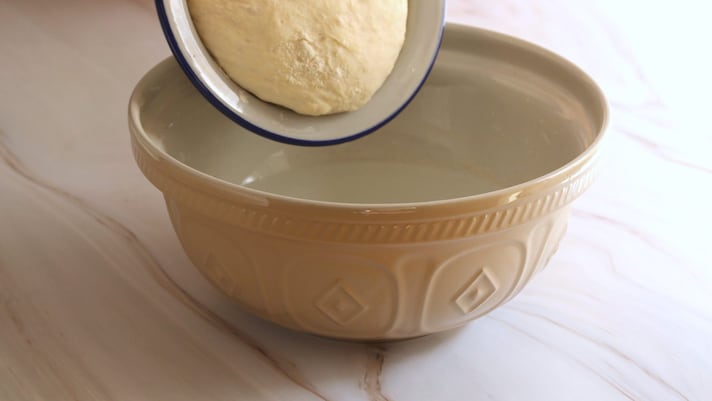
Collect the water at room temperature in a large bowl, add the refreshed and strong yeast, then melt it.
Collect the water at room temperature in a large bowl, add the refreshed and strong yeast, then melt it.
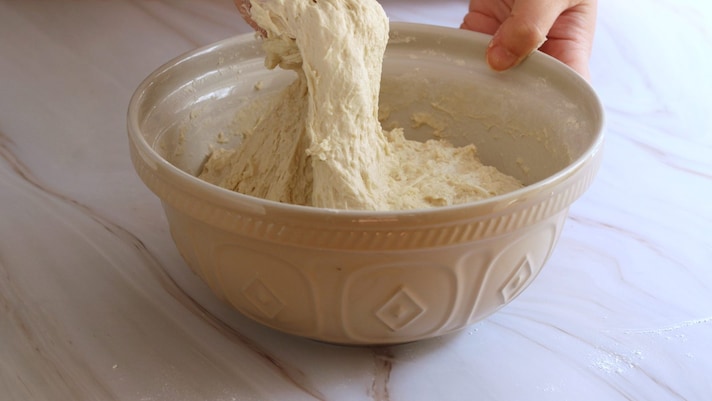
Also add the flour and then the salt, then knead by pinching the mixture and folding it over itself.
Also add the flour and then the salt, then knead by pinching the mixture and folding it over itself.
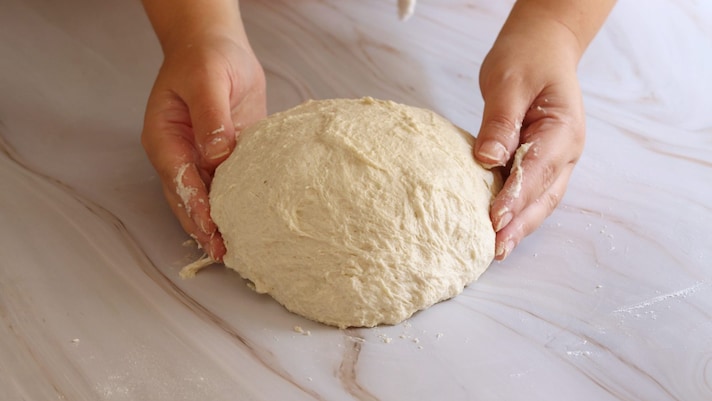
As soon as the consistency appears elastic, form a loaf; don't worry if the dough is still soft and sticky.
As soon as the consistency appears elastic, form a loaf; don't worry if the dough is still soft and sticky.
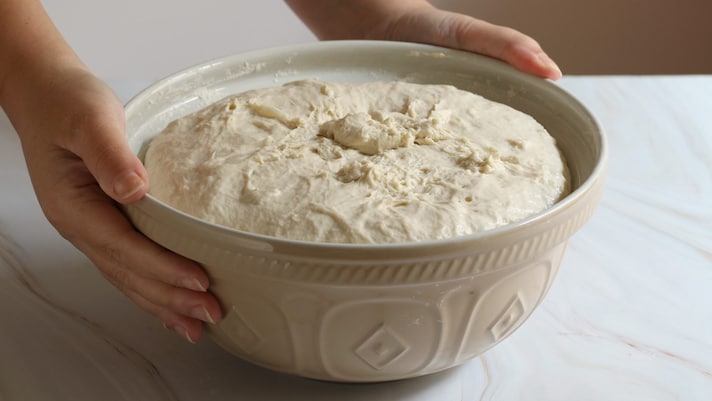
Place it in a covered bowl and let it rise for 6-8 hours depending on the external temperature, until the dough has doubled its initial volume.
Place it in a covered bowl and let it rise for 6-8 hours depending on the external temperature, until the dough has doubled its initial volume.
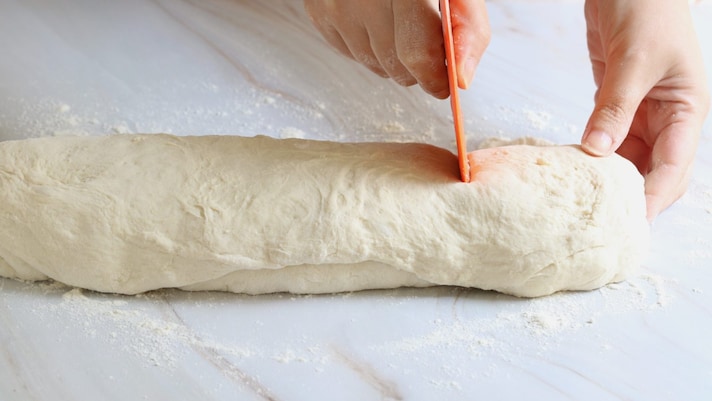
At this point, turn it over onto a floured surface, spread it out with the palms of your hands and then roll the resulting rectangle into a loaf, then divide it into 4 equal portions of 300 grams.
At this point, turn it over onto a floured surface, spread it out with the palms of your hands and then roll the resulting rectangle into a loaf, then divide it into 4 equal portions of 300 grams.
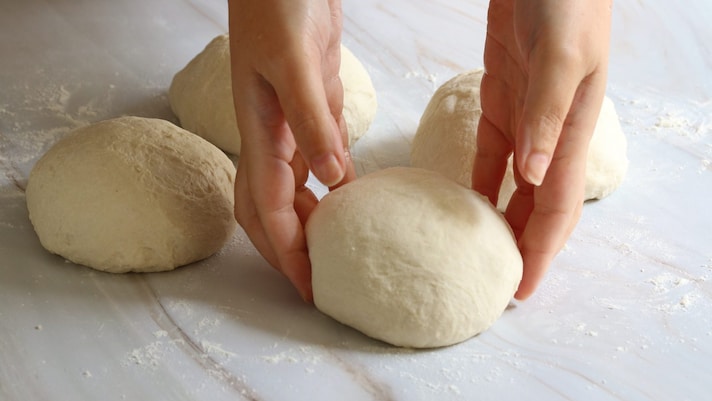
Shape each portion into smooth, regular balls; arrange them, well spaced apart, on a lightly floured cutting board, cover them with a cloth and let them rise for 2 hours. Alternatively, you can close them in the appropriate leavening box.
Shape each portion into smooth, regular balls; arrange them, well spaced apart, on a lightly floured cutting board, cover them with a cloth and let them rise for 2 hours. Alternatively, you can close them in the appropriate leavening box.
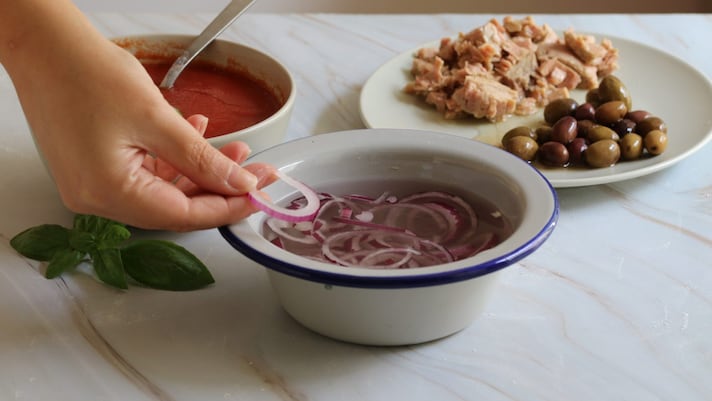
Meanwhile, prepare the dressing: season the tomato puree with a drizzle of oil and a pinch of salt, slice the onions and immerse them in water, drain the tuna and stone the olives, cut the mozzarella into small pieces and drain it well from its whey.
Meanwhile, prepare the dressing: season the tomato puree with a drizzle of oil and a pinch of salt, slice the onions and immerse them in water, drain the tuna and stone the olives, cut the mozzarella into small pieces and drain it well from its whey.
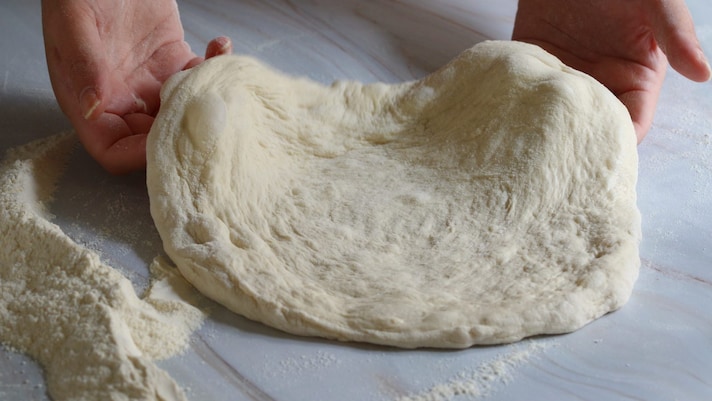
Place one ball at a time on a surface sprinkled with plenty of semolina flour, then roll it out by pressing with your fingertips, starting from the center and leaving the edge thicker.
Place one ball at a time on a surface sprinkled with plenty of semolina flour, then roll it out by pressing with your fingertips, starting from the center and leaving the edge thicker.
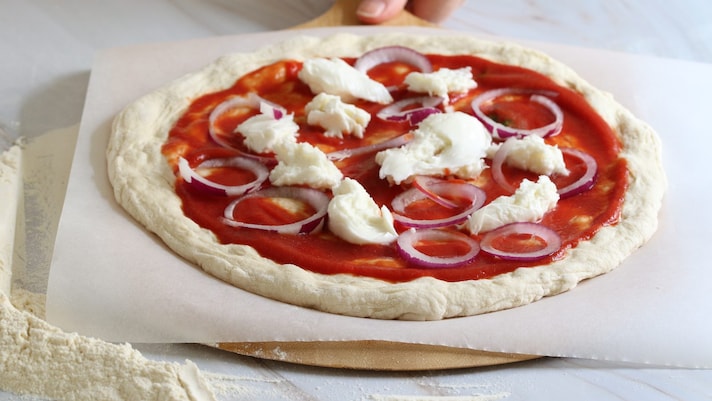
Remove the excess flour and transfer the dough disc onto a square of baking paper, then season it with the sauce, the mozzarella and the onion rings.
Remove the excess flour and transfer the dough disc onto a square of baking paper, then season it with the sauce, the mozzarella and the onion rings.
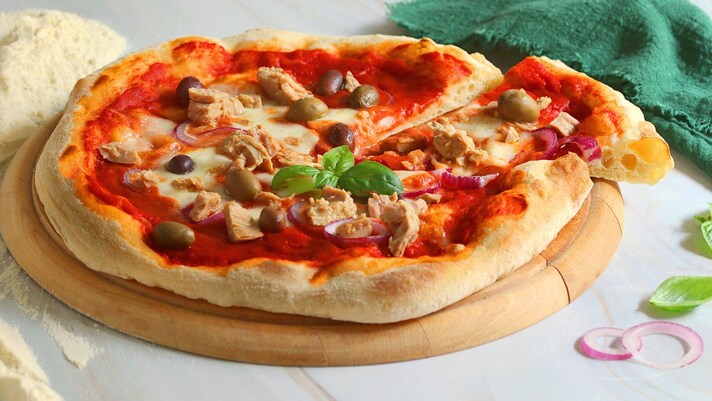
Slide the pizza onto a hot baking tray, positioned at the base of the oven at maximum power (at least 480°F/250°C), and cook for 10 minutes, then move it to the highest level, under the heating elements, for another 5 minutes, to simulate cooking in a professional oven. Remove from the oven and complete with tuna, olives and fresh basil. Your pizza with sourdough is ready to be enjoyed.
Slide the pizza onto a hot baking tray, positioned at the base of the oven at maximum power (at least 480°F/250°C), and cook for 10 minutes, then move it to the highest level, under the heating elements, for another 5 minutes, to simulate cooking in a professional oven. Remove from the oven and complete with tuna, olives and fresh basil. Your pizza with sourdough is ready to be enjoyed.
;Resize,width=767;)
